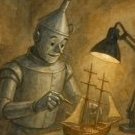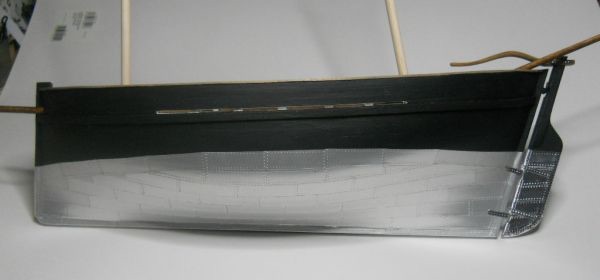This is a follow-up to my query about zinc plating.
To simulate zinc plating on my Mount's Bay lugger model, I ended up using aluminum foil tape purchased at a local big-box building supply store. According to the manufacturer, the adhesive on this duct repair tape was good for a wide range of temperatures, from below freezing to well above boiling, so I figured it would sick all right to the smoothed, primed hull of my model. I cut scale rectangles to represent the 14" by 48" plates, and embossed them around the edges using a pounce wheel to represented the nail heads. I realize that this is not quite correct or realistic, since the nail heads would have been flush with the surface of the plates, or even recessed a little, but I felt that the visual effect of slightly raised nails was important to the overall look of the model. The aluminum foil tape was very shiny, but all it took was a spray with Dullcoat to give the plates a pewter-like appearance, close enough to the appearance of zinc plates.
Below is a photo of the hull, after finishing the application of the plates and spraying with Dullcoat. As I worked up from the keel and forward from the stern, I let the plates follow the curve of the hull, but the topmost row was applied along the waterline. In the photo, the rudder is in place, sheathed with foil plates below the waterline to match the hull, but has not yet been sprayed with Dullcoat. The effect of the Dulcoat on the shiny aluminum plates is clearly apparent.





